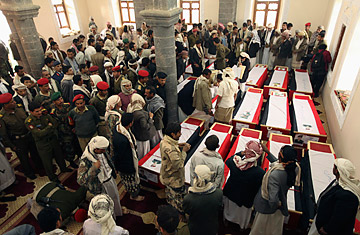
Families of the victims attend a funeral ceremony for Republican Guards killed in a suicide car bomb attack in southern Yemen, at a mosque in Sanaa, Feb. 27, 2012. Al-Qaeda claimed responsibility for the attack that killed at least 26 people outside a presidential palace in southern Yemen on Feb. 25, 2012, hours after Abd-Rabbu Mansour Hadi was sworn in as President.
The raging battle between al-Qaeda and government security forces in southern Yemen in recent days is a reminder that the shadow of insurgency looms large over that country's effort to build a new political order. The swearing in of new president Abd Rabbo Monsour Hadi last week was accompanied by a four-day rampage by Islamist insurgents that left at least 150 soldiers dead, and on Saturday a series of air strikes on jihadist positions — alleged by locals to have been carried out by U.S. drones or warplanes, although local authorities said the Yemeni air force was responsible — left up to 45 suspected insurgents dead.
"Yemen has turned a new page in its history," read a glossy flyer stuck to a wet paving stone in the capital, Sana'a, last week. Written in neat Arabic prose and overlaid on a solemn-looking mug shot of Yemen's new president, the discarded pamphlet chimed with the optimism swirling around the city. After a year of mass demonstrations against him, Ali Abdullah Saleh, a former tank commander turned wily autocrat, had just been eased out of office in an uncontested presidential vote. In his place his former vice president, Hadi, had taken the reins, promising to restructure the army, tackle al-Qaeda and steer the country out of crisis.
It did not take long, however, for reality to bite.
Two hours after Hadi was sworn in as Yemen's new leader a suicide bomber ploughed a Toyota Hilux into the wall of a presidential palace in the southern port of Mukalla, killing dozens of Republican guards. Keen to play down the incident, Hadi labeled it "an isolated attack", and vowed to step up Yemen's decade-long U.S.-funded battle against al-Qaeda in the Arabian Peninsula (AQAP), the local franchise of the network founded by Osama bin-Laden, which had claimed responsibility for the attack.
But it was the jihadists rather than the government that went on the offensive. They stormed military outposts, plunderered ammunition factories, kidnapped and beheaded government soldiers, assassinated police chiefs, and even blew up a fighter jet inside a secure military airbase near the capital. Over 150 soldiers were slain in the four-day rampage, the deadliest spate of attacks against Yemen's armed forces in the past year.
Each attack was followed by a brazen congratulatory press release from AQAP, meticulously documenting the number of casualties inflicted and the weaponry seized. "A tank, a 23mm anti-aircraft gun, a Katyusha rocket launcher, a 120mm Hawn cannon, five 12.7mm Duska guns, 2 RPGS, and 100 Kalashnikovs," read the statement describing a raid on an ammunition base on Tuesday, under the subheading "booty".
"He was an FBI agent targeted because of increasing U.S. activity in Yemen and the bringing of a large number of U.S. soldiers to Aden in particular," read another, referencing an attack by a gunman who opened fire on a U.S. armored vehicle in the southern port city of Aden last Thursday. "The Crusader enemy has set foot on your land to kill your sons... to rule your country and steal its riches. We urge you to carry out jihad against the Americans and their agents," it said, citing a religious edict from the group exhorting Yemenis to "fight the American occupiers".
The bloodiest and most daring assault was a stealthy, medieval-style raid in the early hours of Sunday morning on a Yemeni garrison on the coastal road between Aden and Zinjibar. At least 90 soldiers were killed after the militants sneaked through the desert to the back lines of Yemeni forces before storming the base, killing or capturing soldiers and looting weaponry as they went.
